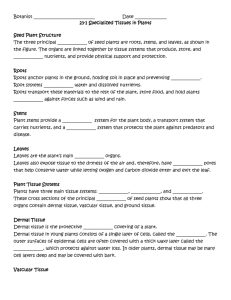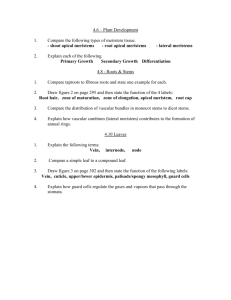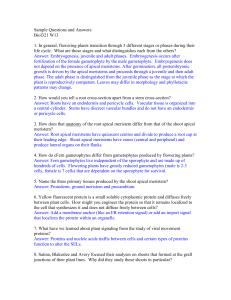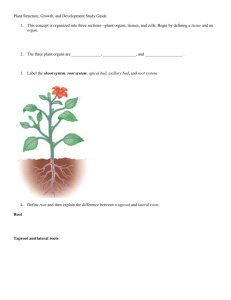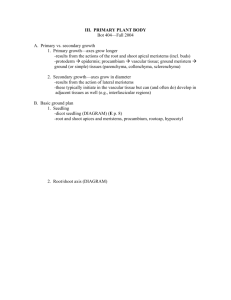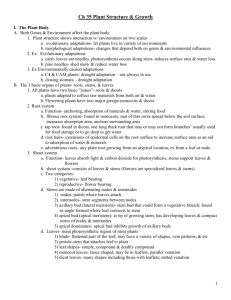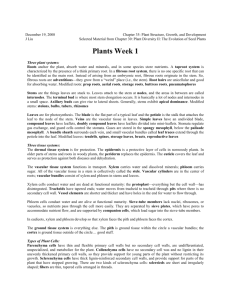Instructor's Manual to accompany Principles of Life
advertisement
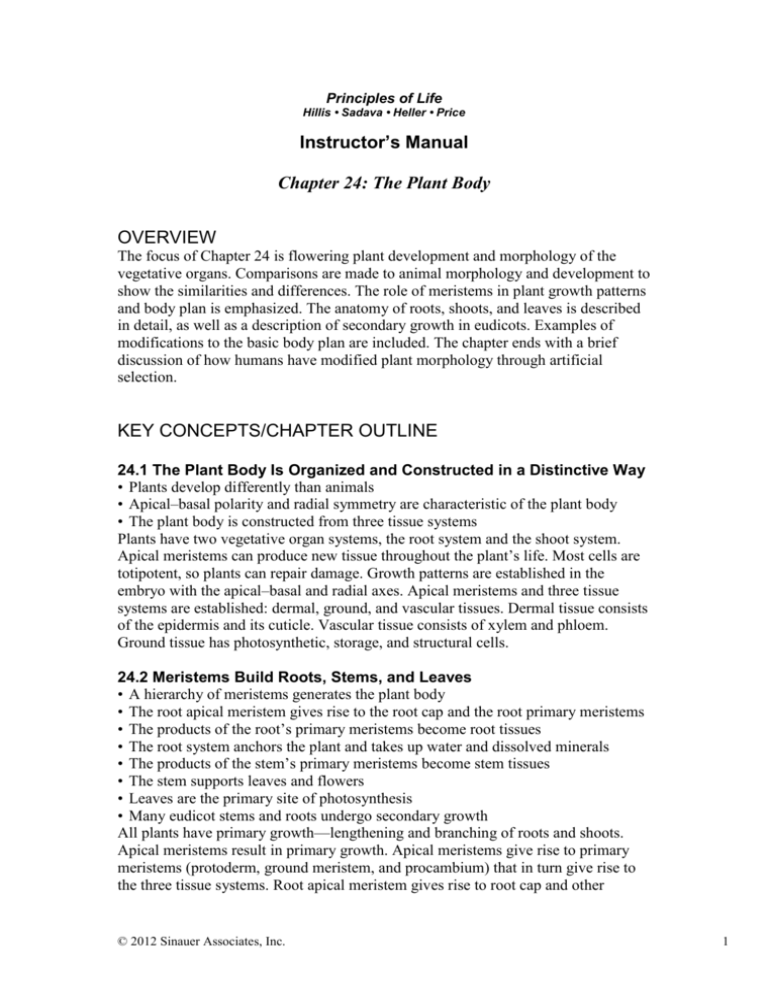
Principles of Life Hillis • Sadava • Heller • Price Instructor’s Manual Chapter 24: The Plant Body OVERVIEW The focus of Chapter 24 is flowering plant development and morphology of the vegetative organs. Comparisons are made to animal morphology and development to show the similarities and differences. The role of meristems in plant growth patterns and body plan is emphasized. The anatomy of roots, shoots, and leaves is described in detail, as well as a description of secondary growth in eudicots. Examples of modifications to the basic body plan are included. The chapter ends with a brief discussion of how humans have modified plant morphology through artificial selection. KEY CONCEPTS/CHAPTER OUTLINE 24.1 The Plant Body Is Organized and Constructed in a Distinctive Way • Plants develop differently than animals • Apical–basal polarity and radial symmetry are characteristic of the plant body • The plant body is constructed from three tissue systems Plants have two vegetative organ systems, the root system and the shoot system. Apical meristems can produce new tissue throughout the plant’s life. Most cells are totipotent, so plants can repair damage. Growth patterns are established in the embryo with the apical–basal and radial axes. Apical meristems and three tissue systems are established: dermal, ground, and vascular tissues. Dermal tissue consists of the epidermis and its cuticle. Vascular tissue consists of xylem and phloem. Ground tissue has photosynthetic, storage, and structural cells. 24.2 Meristems Build Roots, Stems, and Leaves • A hierarchy of meristems generates the plant body • The root apical meristem gives rise to the root cap and the root primary meristems • The products of the root’s primary meristems become root tissues • The root system anchors the plant and takes up water and dissolved minerals • The products of the stem’s primary meristems become stem tissues • The stem supports leaves and flowers • Leaves are the primary site of photosynthesis • Many eudicot stems and roots undergo secondary growth All plants have primary growth—lengthening and branching of roots and shoots. Apical meristems result in primary growth. Apical meristems give rise to primary meristems (protoderm, ground meristem, and procambium) that in turn give rise to the three tissue systems. Root apical meristem gives rise to root cap and other © 2012 Sinauer Associates, Inc. 1 tissues. Eudicots typically form a taproot; monocots have fibrous root systems. Shoots are composed of repeating units called phytomers; shoots grow by adding more phytomers. The vascular tissue is arranged in bundles in the stem. Leaf anatomy is well suited for photosynthesis, including adaptations for intercepting sunlight, efficient gas exchange while limiting water loss, and effective transport systems. Leaves and stems can be modified for other roles such as storing nutrients or water. Some eudicots have secondary growth, which originates from lateral meristems. Wood and bark are derived from the vascular cambium and cork cambium. 24.3 Domestication Has Altered Plant Form A simple body plan underlies the diversity of plant forms that exist today. The body plan is subject to natural selection, as any modifications may confer a competitive advantage, such as for intercepting sunlight. Humans have modified the morphology of many crop plant species by artificial selection. Examples include the development of corn from the wild grass teosinte and the many vegetable forms derived from wild mustard (Brassica oleracea). LECTURE OUTLINE Chapter 24 Opening Question What are the properties of the kenaf plant that make it suitable for papermaking? Concept 24.1 The Plant Body Is Organized and Constructed in a Distinctive Way Plants must harvest energy from sunlight and mineral nutrients from the soil. Body plans and physiology enable plants to do these things. They also grow throughout their lifetime; they can redirect growth to respond to environmental opportunities. Two systems of plant vegetative organs: Root system—anchors plant, absorbs water and minerals, stores products of photosynthesis. Branching increases surface area. Shoot system Leaves—main photosynthetic organs Stems—hold leaves up in the sunlight; connect roots and leaves FIGURE 24.1 Vegetative Plant Organs and Systems Plant development is influenced by three unique properties: • Apical meristems • Cell walls • Totipotency of most cells. Apical meristems are always embryonic, producing new tissues throughout the plant’s life. © 2012 Sinauer Associates, Inc. 2 (LINK Concept 14.1 The processes of development) Cell walls are a rigid extracellular matrix. Plant morphogenesis occurs through changes in the plane of cell division at cytokinesis. This changes the direction of tissue growth. Cytokinesis can be uneven; location of the cell plate is determined by differentiation signals early in mitosis. FIGURE 24.2 Cytokinesis and Morphogenesis Most plant cells are totipotent (can differentiate into any kind of cell). Plants can readily repair damage caused by the environment or herbivores. Two growth patterns are established in the embryo: • Apical–basal axis: arrangement of cells and tissues along the main axis • Radial axis: concentric arrangement of the tissue systems (VIDEO 24.1 Germination of soybean plants) FIGURE 24.3 Two Patterns for Plant Morphogenesis First division of zygote is uneven; sets up apical-basal axis and polarity. • Smaller cell becomes the embryo • Larger cell becomes a supporting structure (suspensor) FIGURE 24.4 Plant Embryogenesis In eudicots, the cotyledons begin to grow, and a shoot apical meristem forms between them. At the other end of the embryo, a root apical meristem forms. Three tissue systems are established during embryogensis: 1. Dermal—forms epidermis, usually one cell layer. Some cells differentiate: • Stomata—pores for gas exchange • Trichomes—leaf hairs, protect from herbivores and damaging solar radiation • Root hairs—increase root surface area Aboveground epidermal cells secrete a waxy cuticle. Limits water loss, reflects damaging solar radiation, barrier against pathogens. FIGURE 24.5 Three Tissue Systems Extend throughout the Plant Body 2. Ground tissue—between dermal and vascular tissue; Three cell types: • Parenchyma cells • Collenchyma cells © 2012 Sinauer Associates, Inc. 3 • Sclerenchyma cells Parenchyma cells • most abundant • large vacuoles and thin cell walls • do photosynthesis • store protein and starch IN-TEXT ART, Ch. 24, p. 510 (1) Collenchyma cells • elongated • thick cell walls • provide support IN-TEXT ART, Ch. 24, p. 510 (2) Sclerenchyma cells • very thick walls reinforced with lignin • undergo programmed cell death • cell walls remain to provide support IN-TEXT ART, Ch. 24, p. 510 (4) 3. Vascular tissue—the transport system Xylem carries water and minerals from roots to rest of plant. (In-Text Art, Ch. 24, p. 510 [5]) Phloem • living cells • moves carbohydrates from production sites to sites where they are used or stored IN-TEXT ART, Ch. 24, p. 511 (1) Concept 24.2 Meristems Build Roots, Stems, and Leaves Primary growth—lengthening of shoots and roots; branching. Results in nonwoody tissues—herbaceous Secondary growth—increase in thickness Woody plants have a secondary plant body consisting of wood and bark. Many vegetative organs have evolved novel roles, such as roots or stems that are used to store water. These are examples of natural selection working with what is already present and the interaction between evolution and development. (LINK Concepts 14.4 and 14.5 Evolutionary developmental biology) © 2012 Sinauer Associates, Inc. 4 When cells divide in meristem tissue, one daughter cell can differentiate, the other remains undifferentiated. Apical meristems result in primary growth; cell division followed by cell elongation Lateral meristems result in secondary growth FIGURE 24.6 Apical and Lateral Meristems Apical meristems can divide indefinitely, so growth of roots and shoots is indeterminate. Apical meristems produce primary meristems. (In-Text Art, Ch. 24, p. 511 [2]) Root apical meristems Daughter cells on the root tip form the root cap—protects root as it pushes through soil. Root cap cells detect gravity and control downward growth of the root. Above the root cap, three zones result as cells divide and mature. (APPLY THE CONCEPT Meristems build roots) FIGURE 24.7 Tissues and Regions of the Root Tip Root primary meristems give rise to root tissues: • Protoderm produces the epidermis; many epidermal cells have root hairs. • Ground meristem produces the cortex, consisting of parenchyma cells and the endodermis. Endodermal cells have waterproof suberin in the cell walls and can control movement of water and mineral ions into the vascular system. • Procambium produces the vascular cylinder (stele), made up of pericycle, xylem, phloem. (LINK Concept 25.3 The role of the endodermis is described in more detail) Pericycle has 3 functions: • Tissue within which lateral roots arise. • Contributes to secondary growth by giving rise to lateral meristems. • Membrane transport proteins export nutrient ions into the xylem. FIGURE 24.8 Products of the Root’s Primary Meristems Angiosperm roots begin to grow as a radicle, which develops into the primary root (taproot) in eudicots. Taproots often store nutrients (e.g., carrots, beets, sweet potato). Monocots form a fibrous root system; roots are equal in diameter (e.g., grasses, leeks). Also called adventitious roots. Some monocots have prop roots to support the shoot (e.g., corn, banyan trees). © 2012 Sinauer Associates, Inc. 5 FIGURE 24.9 Root Systems of Eudicots and Monocots Shoots are composed of repeating modules (phytomers). Each has a node with attached leaves, internode (stem section), and one or more axillary buds. Shoots grow by adding more phytomers. (VIDEO 24.2 Time-lapse of bud burst in plants) Shoot apical meristem also produces three primary meristems, which give rise to shoot tissue systems. Stems have vascular bundles with xylem, phloem, and fibers. The bundles have different arrangements in eudicots and monocots. FIGURE 24.10 Vascular Bundles in Stems Stem modifications Potato tubers are underground stems; the “eyes” are axillary buds. Many desert plants have enlarged stems that store water. Strawberry plant runners are horizontal stems from which roots grow. If the runners break, new plants develop on either side (asexual reproduction). FIGURE 24.11 Modified Stems Growth of leaves is determinate: they stop growing once they reach a predetermined mature size. Leaves consist of a blade, attached to the plant stem by a petiole. Leaves are often oriented perpendicular to the sun’s rays, to maximize the amount of light for photosynthesis. Leaf anatomy is well adapted to: • Carry out photosynthesis • Exchange O2 and CO2 with the environment • Limit evaporative water loss • Export products of photosynthesis to the rest of the plant Leaf mesophyll has two zones of photosynthetic parenchyma tissue. A network of air spaces allows CO2 to diffuse to photosynthetic cells. Vascular bundles form veins that extend to within a few diameters of all cells—to ensure transport of water and minerals in and carbohydrates out. (LINK Concepts 6.5 and 6.6 Photosynthesis is described) FIGURE 24.12 Eudicot Leaf Anatomy Leaf surfaces are covered with nonphotosynthetic epidermal cells. They secrete the waterproof cuticle. © 2012 Sinauer Associates, Inc. 6 Water and gases are exchanged through pores called stomata. Leaves can also be modified for other functions: • Nutrient storage (e.g., onion bulbs) • Water storage (e.g., in succulent plants) • Protection (e.g., cacti have spines that are modified leaves) • Tendrils that wrap around structures to support climbing plants (e.g., peas) Many eudicot stems and roots have secondary growth: Wood and bark are derived by secondary growth from the two lateral meristems: • Vascular cambium produces secondary xylem (wood) and secondary phloem (inner bark). • Cork cambium produces waxy-walled protective cells; some become the outer bark. FIGURE 24.13 A Woody Twig Has Both Primary and Secondary Tissues A stem or root increases in diameter when cells of the vascular cambium divide, producing secondary xylem cells toward the inside and secondary phloem cells toward the outside. Some cells of the secondary phloem divide and form a cork cambium, which produces layers of protective cork. The cork soon becomes the outermost tissue of the stem or root. (ANIMATED TUTORIAL 24.1 Secondary Growth: The Vascular Cambium) Cork cambium produces cells to the inside, forming the phelloderm. Periderm—secondary dermal tissue composed of cork cambium, cork, and phelloderm Bark—periderm plus secondary phloem In temperate zones, annual rings form in the wood. In spring, tracheids or vessel elements tend to be large in diameter and thin-walled. In summer, thick-walled, narrow cells are produced. FIGURE 24.14 Annual Rings Monocots do not have secondary growth. A few have thickened stems (e.g., palms). Palms have a very wide apical meristem that produces a wide stem, and dead leaf bases add to the diameter of the stem. Concept 24.3 Domestication Has Altered Plant Form A simple body plan underlies the diversity of flowering plant forms. Plant body form is subject to natural selection. © 2012 Sinauer Associates, Inc. 7 Example: some plants have become vines; the climbing phenotype gives them access to light in crowded conditions. Humans domesticate crop plants by artificial selection for phenotypes best suited for agriculture. Corn was domesticated from the wild grass teosinte, which still grows in Mexico. Teosinte is highly branched; corn has a single shoot. Branching is controlled by a single gene that regulates axillary buds. FIGURE 24.15 Corn Was Domesticated from the Wild Grass Teosinte Brassica oleracea (wild mustard) is the ancestor of several morphologically diverse crops: kale, broccoli, brussels sprouts, cabbage. Starting with diverse populations of wild mustard, humans selected and planted seeds from variants with traits they found desirable. FIGURE 15.4 Many Vegetables from One Species Answer to Opening Question • Kenaf grows rapidly, reaching 4–5 meters in 5 months. • There are over 500 known genetic strains. • Since its domestication, it has been selected to grow taller and branch less. • The adventitious roots have become longer (2 meters!), and more numerous, promoting growth in dense stands. Kenaf phloem fibers are longer than wood fibers, which makes stronger products. Cells walls don’t have lignin, making it easier to pulp. A hectare of kenaf produces 3 times more fiber than a hectare of southern pine (which takes 20 years to grow). FIGURE 24.16 Kenaf Stems KEY TERMS adventitious apical meristems bark blade collenchyma cork cork cambium cortex cotyledons cuticle dermal tissue system determinate endodermis epidermis © 2012 Sinauer Associates, Inc. 8 fibers fibrous root system ground meristem ground tissue system indeterminate lateral meristems lateral roots leaves mesophyll parenchyma pericycle periderm petiole phloem pith primary growth primary meristems procambium prop roots protoderm root apical meristem root cap root system roots sclereids sclerenchyma secondary growth shoot apical meristem shoot system sieve tube elements stele stems suspensor taproot tissue systems tracheids vascular bundles vascular cambium vascular tissue system vessel elements xylem zone of cell division zone of cell elongation zone of cell maturation © 2012 Sinauer Associates, Inc. 9
